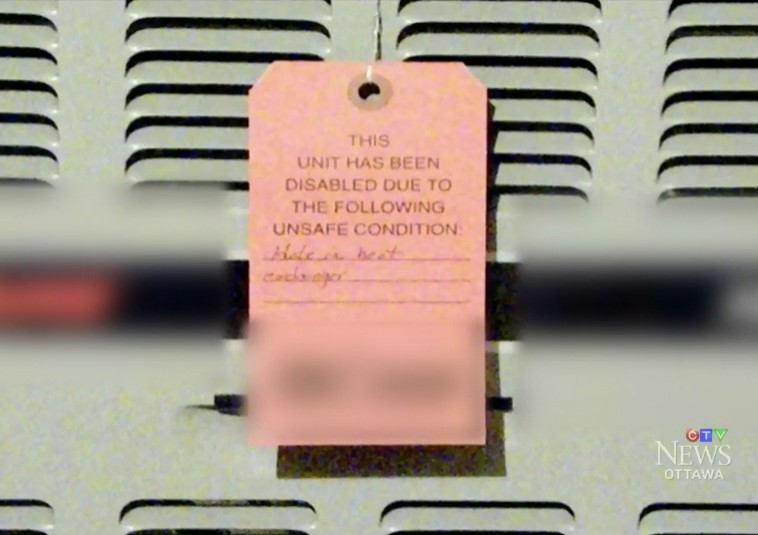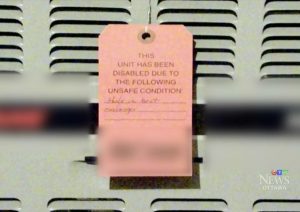Is That Furnace Red Tag a Scam or For Real?
- February 15, 2017
- Posted by: ATEL Air
- Category: Heating, News

 Recently, CTV news did a piece about fake red tags issued to furnaces that didn’t need to be shut down.
Recently, CTV news did a piece about fake red tags issued to furnaces that didn’t need to be shut down.
Unfortunately there are some unscrupulous companies out there, and some consumers were paying to replace furnaces that were working fine.
So how do you tell if a red tag is legitimate?
Why Red Tags are Important
First of all, you need to know what a red tag means.
A red tag is placed on a furnace that needs to be shut down because it’s a health hazard or could even kill you. According to the law (specifically CSA B149.1-10 Natural Gas and Propane Installation Code), a technician is obligated to shut down furnaces that could injure or kill the people in the home.
What’s the concern? These furnaces often have one or more problems that can cause dangerous combustion gasses, in particular carbon monoxide (CO) to escape into your home.
CO is colourless and odourless, and it’s a natural byproduct when anything burns. Normally it goes harmlessly up the exhaust vent. But it’s deadly if it leaks into your home – it’s also the same gas that makes it dangerous to start your car with the garage door closed. Because it makes people disoriented and “sleepy”, entire families have been killed by CO without even knowing it. Tragically, it happens almost every year.
If the choice is between causing problems and expense versus saving lives, the technician must choose to save lives.
Why Fake a Red Tag?
The Red Tag rule is supposed to save lives, but clearly some companies are abusing it by making false claims. Here’s how the scenario often works:
- A technician says a furnace is dangerous and needs to be shut down until it’s repaired or replaced.
- Instead of a low cost maintenance check or medium cost repair, you end up having to replace the entire furnace and the crooked company makes a lot more money. It’s winter, and it’s freezing, and you worry about frozen plumbing, so that adds a sense of urgency to the scenario.
Often the problem cited by the technician is a “cracked heat exchanger” – which is expensive to replace, even when under warranty. If the furnace is more than 15 years old, it often makes more sense just to get a new one.
How Do Technicians Test for Dangerous Cracks in Heat Exchangers?
Cracked heat exchangers do happen, and when they do it’s serious. Here’s how we check to see if there’s a problem.
Our first clue that there may be issues with a heat exchanger is observing the flame pattern in the furnace. It can start to “dance” and move around once the indoor blower comes on. We can sometimes find the problem with an electronic combustion analyser – the oxygen level will change as the blower comes on and forces air into the heat exchanger through the crack.
When we suspect a problem, the next step is to confirm the location. Cracks can often be seen with the naked eye – once you find the location.
Sometimes this is as easy as opening an inspection port into the ductwork just above the furnace and looking into the top of the furnace with a flashlight. Sometimes we must use a dye and a black light to confirm a small leak – this is because cracks expand when heated. On occasion we must remove the exchanger right out of the furnace to pinpoint the crack or leak.
Some are small and some are huge as you may see in the photos. The larger cracks and leaks are heat exchangers that have been running for longer periods of time without regular maintenance and inspection.

Some examples of holes and cracks we’ve seen in heat exchangers. On the far left, the hole is very large, because the furnace has run for a couple years without regular inspections and monthly filter changes. The middle two images show fine cracks. The furnace on the far right has been corroded by combustion gasses. This corrosion has caused the inside white lining to flake off and block the flue gases- requiring shut down the furnace and NO HEAT!
What Should You Do When Your Furnace is Red Tagged?
The main thing is to get proof. Any honest technician will gladly reveal the crack and unsafe heat exchanger and allow you the opportunity to confirm for yourself.
- Always ask the service technician to show you the heat exchanger and the crack.
- Ask for a copy of the picture if the tech took a picture of the crack.
- If an electronic combustion analyser was used to find the problem, the readings should be recorded on the work order.
- If you’re in doubt, hire another company to get a second opinion.
If you believe the technician is telling the truth, ask these follow up questions:
- Why did it crack? What caused it to fail? (Causes can vary; sometimes the furnace is over 20 years old and has worn out, or improper installation can play a role if the furnace is only a couple years old. Whatever it was, the technician should be able to communicate a possible cause).
- Is the heat exchanger still under warranty and available from the manufacturer? Do they provide written estimates in advance?
If you are unsure and still not comfortable with the answers ask for referrals of other customers who have experienced the same problem. Then call ATEL Air…we will gladly give you a free second opinion (ask us for details when you call).
Stay warm,
Jimmie


